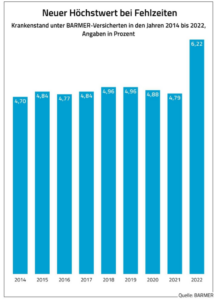“A manager takes their sick leave with them when they are transferred or promoted.”
When I start training managers on the topic of ‘healthy leadership’ with this sentence, I’m sure to attract attention, …but also headwinds – so here’s another way to start.
The topic of ‘healthy leadership’ has played a relevant role in many companies and organisations for many years – and rightly so. The health of employees is a relevant economic factor, because – to put it pragmatically – only those who are present can perform. And: only those who feel good at work can perform well.
“Good working conditions and quality of life in the workplace sustainably promote health and motivation on the one hand and increase a company’s productivity, product and service quality and innovative capacity on the other.” (cf. https://de.wikipedia.org/wiki/Betriebliches_Gesundheitsmanagement, 2023-08-30; 13:44)
The role of leadership in employee health
And one factor that – in addition to occupational health and safety measures – has a demonstrable influence on the health of employees is indeed leadership. Back to the sentence quoted at the beginning: “A manager takes their sick leave with them when they are transferred or promoted.” This admittedly rather provocative statement summarises the results of a study in the VW Group and is confirmed by numerous internal observations by HR developers and managers: If a manager with a high sickness rate in their department takes over the management of another – previously ‘healthier’ – department, a similarly high sickness rate occurs there after some time.
cf. Nieder, P. (2001). Leadership and health. The role of the superior in health management. In: U. Brandenburg, P. Nieder & B. Susen (eds.), Gesundheitsmanagement im Unternehmen: Fundamentals, concepts and evaluation (pp. 149-161).
According to a survey by the German Barmer Krankenkasse, absenteeism is currently at a new high:

The question therefore arises quite acutely: What can you as a manager do in practice to increase your employees’ attendance times and also offer them an environment in which they enjoy working?
Structural measures from the repertoire of occupational health management (OHM), such as the design of the working environment, the specific layout of work tasks and the organisation of work, offer starting points. However, the extent to which individual managers can exert influence varies depending on their position and organisational form.
The behaviour of the manager is particularly relevant
A key lever that lies within every manager’s sphere of influence is their specific behaviour. Management behaviour has an influence on the health of employees. This has been proven time and again by various studies over the years. Here are just two examples:
A study conducted by the Bertelsmann Foundation in May 2012 found that line managers can reduce the frequency of burnout by providing social support. Managers who are approachable, support their employees and allow them to make mistakes create an environment that leads to greater satisfaction, reduces stress and increases motivation.
Bertelsmann Foundation (2010): Supervisors can reduce burnout in the workplace. www.bertelsmann-stiftung.de
ETH Zurich has established the following correlation: When managers took up their employees’ ideas, gave praise and also admitted their own mistakes, the number of days of absence fell by two.
Prof. Fischer, ETH Zurich, CASH, 10 February 2005 (quoted from Matyssek (2020): Healthy leadership – yourself and others!)
5 concrete recommendations for healthy leadership
The two study results already outline some pragmatic recommendations for healthy leadership behaviour:
- Be approachable!
- Deal constructively with mistakes – including your own!
- Praise (more often)!
- Take up ideas from your employees!
- Create a relaxed working environment!
What sounds very simple in the description is often a challenge in everyday working life. The path from knowledge to action can be rocky and may fail at several points – crossroads, bridges.
If you are interested in being supported on this challenging path, please get in touch. Our executive coaching and leadership programmes are guaranteed to take you further.
Image: pixabay, 2023-10-20; 18:18, fahribaabdullah14



